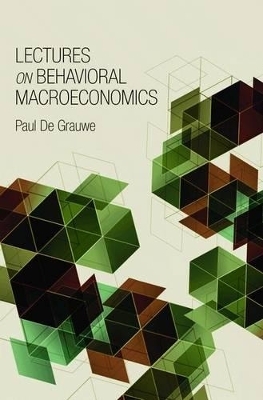
Lectures on Behavioral Macroeconomics
Princeton University Press (Verlag)
978-0-691-14739-0 (ISBN)
- Lieferbar (Termin unbekannt)
- Versandkostenfrei innerhalb Deutschlands
- Auch auf Rechnung
- Verfügbarkeit in der Filiale vor Ort prüfen
- Artikel merken
In mainstream economics, and particularly in New Keynesian macroeconomics, the booms and busts that characterize capitalism arise because of large external shocks. The combination of these shocks and the slow adjustments of wages and prices by rational agents leads to cyclical movements. In this book, Paul De Grauwe argues for a different macroeconomics model--one that works with an internal explanation of the business cycle and factors in agents' limited cognitive abilities. By creating a behavioral model that is not dependent on the prevailing concept of rationality, De Grauwe is better able to explain the fluctuations of economic activity that are an endemic feature of market economies. This new approach illustrates a richer macroeconomic dynamic that provides for a better understanding of fluctuations in output and inflation. De Grauwe shows that the behavioral model is driven by self-fulfilling waves of optimism and pessimism, or animal spirits. Booms and busts in economic activity are therefore natural outcomes of a behavioral model.
The author uses this to analyze central issues in monetary policies, such as output stabilization, before extending his investigation into asset markets and more sophisticated forecasting rules. He also examines how well the theoretical predictions of the behavioral model perform when confronted with empirical data. * Develops a behavioral macroeconomic model that assumes agents have limited cognitive abilities * Shows how booms and busts are characteristic of market economies * Explores the larger role of the central bank in the behavioral model * Examines the destabilizing aspects of asset markets
Paul De Grauwe is professor of international economics at the London School of Economics and Political Science. He is the author or coauthor of several books, including The Exchange Rate in a Behavioral Finance Framework (Princeton) and Economics of Monetary Union.
Preface vii 1 A Behavioral Macroeconomic Model 1 1.1 Introduction 1 1.2 The Model 3 1.3 Introducing Heuristics in Forecasting Output 5 1.4 Heuristics and Selection Mechanism in Forecasting Inflation 10 1.5 Solving the Model 11 1.6 Animal Spirits, Learning, and Forgetfulness 12 1.7 Conditions for Animal Spirits to Arise 16 1.8 Two Different Business Cycle Theories: Behavioral Model 19 1.9 Two Different Business Cycle Theories: New Keynesian Model 20 1.10 Uncertainty and Risk 25 1.11 Credibility of Inflation Targeting and Animal Spirits 27 1.12 Different Types of Inertia 31 1.13 Animal Spirits in the Macroeconomic Literature 33 1.14 Conclusion 34 Appendix 1: Parameter Values of the Calibrated Model 36 Appendix 2: Matlab Code for the Behavioral Model 37 Appendix 3: Some Thoughts on Methodology in Mainstream Macroeconomics 40 2 The Transmission of Shocks 45 2.1 Introduction 45 2.2 The Transmission of a Positive Productivity Shock 45 2.3 The Transmission of Interest Rate Shocks 49 2.4 Fiscal Policy Multipliers: How Much DoWe Know? 52 2.5 Transmission under Perfect Credibility of Inflation Target 55 3 Trade-offs between Output and Inflation Variability 59 3.1 Introduction 59 3.2 Constructing Trade-offs 60 3.3 Trade-offs in the New Keynesian Rational Expectations (DSGE) Model 64 3.4 The Merits of Strict Inflation Targeting 65 4 Flexibility, Animal Spirits, and Stabilization 71 4.1 Introduction 71 4.2 Flexibility and Neutrality of Money 71 4.3 Flexibility and Stabilization 74 5 Animal Spirits and the Nature of Macroeconomic Shocks 79 5.1 Introduction 79 5.2 The Model with Only Supply or Demand Shocks 79 5.3 Trade-offs in the Supply-Shocks-Only Scenario 83 5.4 Trade-offs in the Demand-Shocks-Only Scenario 85 5.5 Conclusion 88 6 Stock Prices and Monetary Policy 91 6.1 Introduction 91 6.2 Introducing Asset Prices in the Behavioral Model 91 6.3 Simulating the Model 94 6.4 Should the Central Bank Care about Stock Prices? 96 6.5 Inflation Targeting and Macroeconomic Stability 99 6.6 The Trade-off between Output and Inflation Variability 101 6.7 Conclusion 105 7 Extensions of the Basic Model 107 7.1 Fundamentalists Are Biased 107 7.2 Shocks and Trade-offs 111 7.3 Further Extensions of the Basic Model 114 7.4 Conclusion 114 8 Empirical Issues 117 8.1 Introduction 117 8.2 The Correlation of Output Movements and Animal Spirits 118 8.3 Model Predictions: Higher Moments 120 8.4 Transmission of Monetary Policy Shocks 122 8.5 Conclusion 124 References 127 Index 133
| Erscheint lt. Verlag | 14.10.2012 |
|---|---|
| Zusatzinfo | 64 line illus. 4 tables. |
| Verlagsort | New Jersey |
| Sprache | englisch |
| Maße | 152 x 235 mm |
| Gewicht | 369 g |
| Themenwelt | Wirtschaft ► Betriebswirtschaft / Management ► Allgemeines / Lexika |
| Wirtschaft ► Volkswirtschaftslehre ► Makroökonomie | |
| Wirtschaft ► Volkswirtschaftslehre ► Mikroökonomie | |
| ISBN-10 | 0-691-14739-6 / 0691147396 |
| ISBN-13 | 978-0-691-14739-0 / 9780691147390 |
| Zustand | Neuware |
| Haben Sie eine Frage zum Produkt? |
aus dem Bereich



